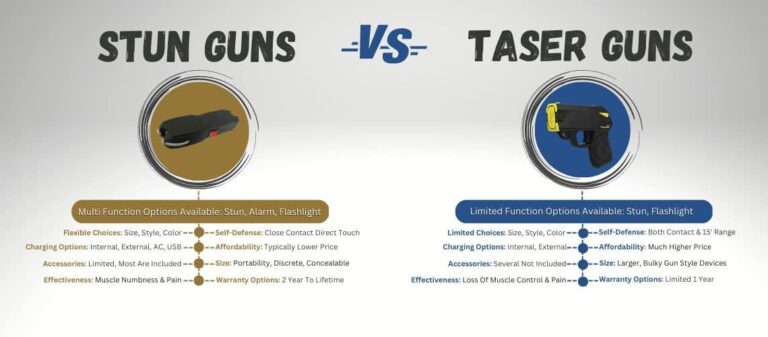When it comes to personal safety, stun guns have become a popular non-lethal option for self-defense. Their ability to incapacitate an attacker quickly and without permanent harm makes them appealing to many. However, a compelling question arises: are stun guns equally effective for everyone, regardless of age or health status? In this article, we’ll explore the factors that influence how stun guns work on different individuals, from young adults to seniors, and how medical conditions might impact their effectiveness. Understanding these nuances can help users make informed choices about their personal protection strategies.
Table of Contents
- Effectiveness of Stun Guns Across Different Age Groups
- Health Considerations Impacting Stun Gun Performance
- Adapting Stun Gun Usage for Vulnerable Populations
- Expert Recommendations for Safe and Effective Use
- In Retrospect
Effectiveness of Stun Guns Across Different Age Groups
When assessing the efficacy of stun guns across various age demographics, it’s essential to consider physiological differences. Younger individuals, typically those under 40, tend to have more robust nervous systems and muscle responsiveness. This biological predisposition means the incapacitating effects of a stun gun-primarily through neuromuscular disruption-are often more immediate and pronounced. Conversely, older adults or seniors might experience a slightly diminished response due to natural decreases in nerve conduction velocity and muscle mass. That said, the overall disruption caused by the electrical charge remains effective enough to serve as a deterrent, although reaction times and recovery speed may vary.
Key factors influencing effectiveness include:
- Individual health status, particularly cardiovascular health and the presence of neurological conditions
- Body composition, such as muscle mass and fat distribution, which can affect current flow
- Age-related changes in skin resistance and conductivity
Ultimately, stun guns maintain their functionality as non-lethal defense tools across age groups, but users should remain mindful of varying thresholds and legal considerations. Medical advisories suggest cautious use with elderly or those having preexisting health issues to prevent inadvertent complications.
Health Considerations Impacting Stun Gun Performance
When it comes to the effectiveness of stun guns, the physiological condition of the user or target plays a significant role. Variables such as age, heart health, and medication can influence how the electrical discharge interacts with the body. For example, younger individuals with healthy cardiovascular systems may experience a more pronounced muscle disruption due to the body’s natural conductivity and responsiveness. In contrast, older adults or those with chronic health issues, like arrhythmias or pacemakers, might respond unpredictably or less intensely. This means stun gun performance is not one-size-fits-all and must be considered carefully when used for personal safety or law enforcement purposes.
Additional factors that impact the efficacy include:
- Body Fat Percentage: Higher fat content can increase resistance to electrical flow, potentially reducing the stun gun’s incapacitation ability.
- Hydration Levels: Dehydrated individuals may conduct electricity differently, affecting the overall effect.
- Medications: Drugs that alter heart rate or nervous system function may either amplify or dampen the stun response.
Adapting Stun Gun Usage for Vulnerable Populations
When considering the use of stun guns for vulnerable populations-such as the elderly, children, or individuals with pre-existing medical conditions-modifications to standard application protocols become essential. The physiological impact of an electrical charge can vary significantly across age groups and health states, potentially causing unintended harm. For example, older adults with cardiac issues or those on certain medications may experience more severe complications, while younger or smaller individuals may be more sensitive to even brief exposures. This necessitates a careful assessment of risk versus necessity before deployment, prioritizing minimal effective charge and targeting to avoid critical areas like the chest.
Best practices recommended for adapting stun gun usage include:
- Reduced voltage and shorter exposure times to minimize health risks without compromising effectiveness.
- Avoiding direct contact with sensitive areas, such as the head, neck, or chest, especially in users with known cardiovascular vulnerabilities.
- Enhanced training for operators to recognize signs of distress quickly and to tailor responses based on individual physical conditions.
- Post-incident medical evaluation to promptly address any adverse reactions that may be unique to vulnerable individuals.
Expert Recommendations for Safe and Effective Use
Ensuring the safe and effective use of stun guns requires a keen understanding of individual health conditions and age-related considerations. Before usage, it is crucial to assess potential risks, especially if the user or target has underlying cardiovascular issues or epilepsy. Stun guns emit an electric shock that can influence heart rhythm, so consultation with a healthcare professional is recommended if uncertainty exists about one’s health status. For seniors or individuals with fragile health, alternate self-defense options might be more suitable to prevent unintended injury.
When incorporating stun guns into personal safety plans, follow these expert tips:
- Understand device specifications: Voltage and amperage vary significantly, directly impacting effectiveness and safety.
- Practice proper handling: Regular drills can build confidence and reduce accidental misfires.
- Avoid prolonged exposure: Short bursts deliver optimal results without escalating risks.
- Store securely: Keep stun guns out of reach of children or unauthorized users.
In Retrospect
In conclusion, while stun guns can be an effective self-defense tool, their impact varies significantly depending on age, health, and individual physiology. Younger, healthier individuals may experience a more pronounced incapacitating effect, whereas older adults or those with certain medical conditions might respond differently – sometimes with less predictable outcomes. It’s essential to consider these factors when evaluating stun guns as a safety option and to remember that no single tool guarantees protection for everyone equally. As always, combining personal awareness, proper training, and adherence to local laws will provide the best foundation for effective and responsible self-defense.



